

Holy Islands and the Otherworld: Places Beyond Water. Holy Islands and the Otherworld: Places Beyond Water By Eldar Heide Isolated Islands in Medieval Nature, Culture and Mind, eds.
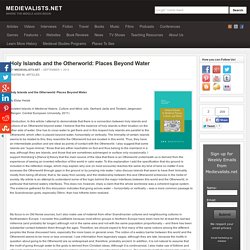
Gerhard Jaritz and Torstein Jørgensen (Bergen: Central European University, 2011) Introduction: In this article I attempt to demonstrate that there is a connection between holy islands and notions of an Otherworld beyond water. I believe that the essence of holy islands is their location on the other side of water. Ancient Music Ireland. DNA study shows Celts are not a unique genetic group. 18 March 2015Last updated at 14:00 ET By Pallab Ghosh Science correspondent, BBC News "What's fascinated historians is why over such a short space of land, the people are so different", as Pallab Ghosh reports A DNA study of Britons has shown that genetically there is not a unique Celtic group of people in the UK.

According to the data, those of Celtic ancestry in Scotland and Cornwall are more similar to the English than they are to other Celtic groups. The study also describes distinct genetic differences across the UK, which reflect regional identities. Celtic Studies. Conical silver-gilt mount decorated with symmetrically arranged animal interlace, Pictish, from St Ninian’s Isle, 8th century.
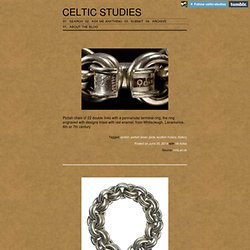
Timeline Photos - Society For The Protection and Promotion of Polytheism. Timeline Photos - Society For The Protection and Promotion of Polytheism. The Mold Gold Cape « thothistheibis. The beautiful Mold Gold Cape is certainly worth having another look at.

This wonderful article was found in 1833 by workmen quarrying for stone when they came upon a stone cist. They had been digging in a burial mound named Bryn yr Ellylon, the Ghost or Goblins’ Hill near Mold, Wales. The person in the cist was wearing the cape. Unfortunately the skeletal remains were fragmentary and the cape crushed and broken into several pieces. Many pieces were removed by various people, and it took many years to gather as much as possible. At first it was thought to have been a corselet or breast plate which passed beneath the arms, but by 1904 the British Museum was presenting it as a chest ornament for a pony. The Amazing Detail The cape was made out of a single ingot of gold, which was then decorated with rows and rows of different shapes. I think of these shapes as houses (large domes); seeds (small domes); lenticular shapes (beans); pyramid shapes ( temples?) Cul a Bhail, Jura Vinca bowl.
CELTIC SHRINES IN CENTRAL EUROPE: A SCEPTICAL APPROACH - VENCLOVÁ - 2007 - Oxford Journal of Archaeology. The Cross Goes North: Processes of Conversion in Northern Europe, AD 300-1300. New Thoughts on Albion, Ierne, and the Pretanic Isles (Part One); Proceedings of the Harvard Celtic Colloquium, Vol. 6 (1986), pp. 1-28. A Catalogue of the Roman Coins from Newgrange, Co. Meath.
Women of History: Celtic Women. La Tène culture. Overview of the Hallstatt and La Tène cultures.

The core Hallstatt territory (800 BCE) is shown in solid yellow, the area of influence by 500 BCE (HaD) in light yellow. Hallstatt culture. An overview of the Hallstatt and La Tène cultures.
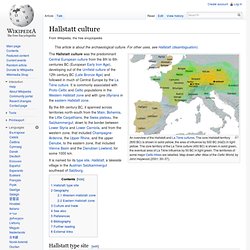
The core Hallstatt territory (800 BC) is shown in solid yellow, the area of influence by 500 BC (HaD) in light yellow. The core territory of the La Tène culture (450 BC) is shown in solid green, the eventual area of La Tène influence by 50 BC in light green. The territories of some major Celtic tribes are labelled. Castro culture. Geography of the Castro Culture, and location of major oppida.

The area of Ave Valley was the core region of this culture, with a large number of small Castro settlements, but also including larger oppida, the cividades (from Latin civitas, city), some known as citânias by archaeologists, due to their city-like structure: Cividade de Bagunte (Civitas Bogonti), Cividade de Terroso (Civitas Terroso), Citânia de Briteiros, and Citânia de Sanfins.[3] History[edit] The Castro culture emerged during the first two centuries of the first millennium BCE, in the region extending from the Douro river up to the Minho, but soon expanding north along the coast, and east following the river valleys,[4] reaching the mountain ranges which separate the Atlantic coast of the Iberian peninsula from the central plateau or meseta.
Building a Celtic Roundhouse. The walls of roundhouses were either dry stone filled in with clay and straw, or a ring of support poles weaved with wattling and plastered in daub, or a mixture of both stone and wattling as being built here (left).
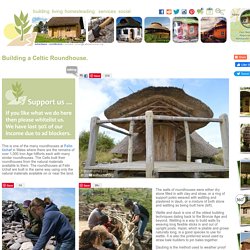
Wattle and daub is one of the oldest building techniques dating back to the Bronze Age and beyond. Wattling is a way to build walls by weaving long flexible sticks in and out of upright posts. Hazel, which is pliable and grows naturally long, is a good species to use for wattle. Thermal baths and Votive offerings. The ancient name of Luxeuil-les-Bains is neither mentioned in the Classical texts nor in the 4th-century Carte de Peutinger, but in The Life of Saint Columbanus, written in the 7th c. by the Italian monk Jonas de Bobbio who describes the foundation of the monastery of Luxeuil (Luxovium) by Saint Colombanus around 590.2135 He refers briefly to the worship of the hot springs by the local pagan people, who offered ex-votos in stone to the deities of the place and performed rites and ceremonies in the nearby wood: ‘Cum iam multorum monachorum societate densaretur, coepit cogitare, ut potioris loci in eodem heremo quereret, quo monasterium construxisset, invenitque castrum firmissimo munimine olim fuisse cultum, a supradicto loco distans plus minus octo millibus, quem prisca tempora Luxovium nuncupabant: ibique aquae calidae cultu eximio constructae habebantur.
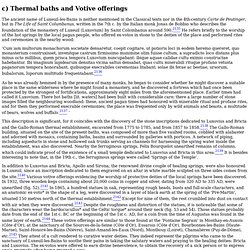
Fig. 54: Head in wood (wearing the Celtic torque*) from the spring of the Pré-Martin, in Luxeuil. In the Musée de Besançon (Doubs). E-Keltoi: Journal of Interdisciplinary Celtic Studies. 16th century Irish hipsters. I recently spotted what appeared to be remarkably modern looking haircuts in Albrecht Druer’s woodcut of 1521 AD[i].
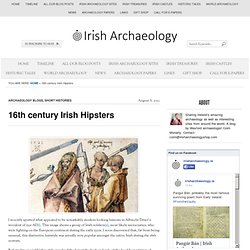
This image shows a group of Irish soldiers[ii], most likely mercenaries, who were fighting on the European continent during the early 1520s. I soon discovered that, far from being unusual, this distinctive hairstyle was actually very popular amongst the native Irish during the 16th century. Referred to as a ‘glib’ this style involved the hair at the back and side of the head being trimmed short, while at the front and top it was allowed to grow long, resulting in a large fringe, which fell down over the face. In 1517 Laurent Vital described this distinctive Irish hair style thus: ‘for they (Irish men) were shorn and shaved one palm above the ears, so that only the tops of their heads were covered with hair. But on the forehead they leave about a palm of hair to grow down to their eyebrows like a tuft of hair which one leaves hanging on horses between the two eyes’[iii].
To A Harp. A meeting of civilisations: The mystery of China's celtic mummies. But this is no early Celt from central Scotland. This is the mummified corpse of Cherchen Man, unearthed from the scorched sands of the Taklamakan Desert in the far-flung region of Xinjiang in western China, and now housed in a new museum in the provincial capital of Urumqi. In the language spoken by the local Uighur people in Xinjiang, "Taklamakan" means: "You come in and never come out. " Celtic and Romano British Foods from the Isles- a General Approach. Book IV 4:122, “their flocks of sheep and herds of swine are so very largethat they supply an abundance of the "sagi" and the salt-meat, not only toRome, but to most parts of Italy as well.”Many different ways of cooking and serving meat were employed.Cooking stones have been used since at least Mesolithic times.
Strawwrapped meat was placed in a boiling pot and heated rocks wereoccasionally dropped into the container to maintain the temperate until themeat was done. A similar method was employed until the 18 th century in theScottish islands. Let's Make Mead: The Ancient Berserker Crunk-Juice of Kings. Got Mead - Mead (honeywine) making, mead drinking, mead recipes. Got Mead? A blackberries and Spices 1 package of Red Star “Premier Cuvee” yeastYeast nutrient4 pounds of clover honey1 gallon of spring water8 ounces of Black berries - Frozen1 whole cloveinch and a quarter ( 1 1/4 ) long section of a vanilla bean. Split length-wise. This is the process that I use for this recipe- First set your black berries out so that they have enough time to thaw.
Melting metal in a home foundry, backyard metalcasting, metal casting. AKA Mary Jones. Saints, Scholars and Pagans? The impact of Paganism on Medieval Irish Christianity « Irish History Podcast. In the film adaptation of “The Field”, the parish priest proclaims Christianity to be a “thin veneer” over Irish people, in a derogatory reference both the people and pre-Christian Paganism alike. This idea of Christianity being a thin veneer runs contrary to the notion of medieval Ireland being an “island of saints and scholars” but is there any truth to this idea?
Exactly how Christian was early Irish Christianity? The Celtic Origin Revised: the Atlantic View and the Nordwestblock Blues « Rokus Blog. Welcome to Tairis.co.uk. The Morrígan and Her Germano-Celtic Counterparts. Morrígna, Mórrígan, Morrígu, Morrigan, Morigain, morrigna, lamia, morigan, Nemain, Macha, Badb, Badba, Fe, Féa, Celtic Mythology, Dagda, Fir Bolg, Valkyrie, Valkyries, Berserks, berserkir, berserkers The Morrígan and her Germano-Celtic Counterparts A dissertation by Angelique Gulermovich Epstein Here and there around us are many bloody spoils; horrible are the huge entrails the Morrígan washes. She has come to us, an evil visitor; it is she who incites us. Dare.uva.nl/document/133032. Romans in Britain - Good Roman Links. Mike Bishop Stuff Roman Military Equipment by Bishop and Coulston--Black and white figures from the second edition Other Stuff Auxilia by GL Cheeseman in digital format Archaeologica News page Demetrius at the Australian National University--Image galleries from several museums.
Corbridge Hoard Photos by Mike Bishop Roman Numismatic Gallery--Military Equipment More Vindonissa photos by Paul Mullins Online Collection of Roman Artifacts De Legione Romana--Includes parts of the Legio XX site in Italian, plus various articles in English as well ROMEC--Roman Military Equipment Conference Carlisle Millenium Project National Museums Scotland, Database search of archeological finds Legio XX Valeria Victrix --A site dedicated to the history of the original Legio XX.V.V., including lists of all known personnel.
Catalog of Roman Legions VRoma: A Virtual Community for Teaching and Learning Classics --Among other things, a HUGE archive of images. Arlington Learning in Retirement Institute Links page--Massive! Diotima: Women & Gender in the Ancient World. Celtic Art and Cultures - Image Search. Entrada. Rewriting the ancient history of Stonehenge. Stonehenge skeleton came from Mediterranean - World news - Europe. North Wales hillfort test of Iron Age communication. On the manners and customs of the ancient Irish - Eugene O'Curry.